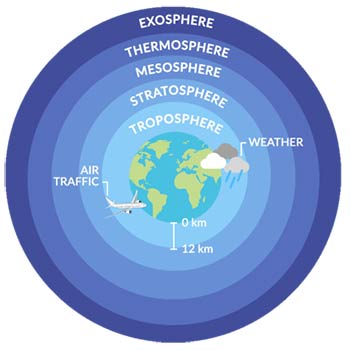
At the very frontier where Earth meets the sky, the troposphere exists as the bustling marketplace of weather, climate, and air we breathe. The layer of the atmosphere envelops us, a dynamic and ever-changing canvas painted with clouds, storms, and the gentle breezes that whisper across the landscape. But what exactly is the troposphere, and why is it so crucial to life on Earth?
The troposphere is the lowest layer of the Earth’s atmosphere, extending from the Earth’s surface up to an average height of about 8 to 15 kilometers (5 to 9 miles), depending on the latitude and season. It is the layer of the atmosphere where we live and where most weather phenomena occur. The troposphere is called the weather sphere because most weather occurs in this lowest layer.
In this exploration, we will dive into the characteristics that define the troposphere, from its role in weather patterns to its impact on global climate systems. Journey with us as we unravel the mysteries of this vital atmospheric layer, discovering how it shapes our world in myriad ways, both seen and unseen. Prepare to be grounded in the science of the troposphere, the closest layer of the atmosphere to our Earthly home.
What is the Troposphere?
The atmosphere is an important part of the Earth and around the Earth from all sides. It extends about 500 kilometers from the ground, and the atmosphere can be divided into many layers. The variation of these layers is based on the temperature. Temperature varies from minus 92 degrees Celsius to 1200 degrees Celsius.

There are five layers of the atmosphere. These are the troposphere, stratosphere, mesosphere, thermosphere, and exosphere. The troposphere is the first layer of the atmosphere. This layer discusses its height, composition, importance, and temperature or lapse rate.
Height
The troposphere is the first layer of the atmosphere, so it is closest to the earth’s surface. Tropo means turning or changing, and the conditions in this layer are more variable than in any other layer of the atmosphere.
We live in the troposphere. The average height of this layer is about from the earth’s surface 11 kilometers. Also, its heights depend upon the latitude season and pressure.
Weather and Climate
The troposphere is the most active layer of the atmosphere regarding weather processes. It is where clouds, precipitation, storms, and other weather phenomena occur. The exchange of heat and moisture within the troposphere drives the development and movement of weather systems, influencing regional and global climate patterns.
Vertical Mixing
The troposphere is characterized by convective mixing as warm air rises and cold air sinks. This vertical mixing helps distribute heat, moisture, and pollutants throughout the layer, affecting atmospheric stability and air quality.
Jet Streams
Jet streams and high-speed air currents are typically found in the upper troposphere. They flow from west to east, significantly steer weather systems, and influence long-term weather patterns.
Human Activities
The troposphere is directly impacted by human activities, mainly through the emission of pollutants and greenhouse gases. Industrial activities, transportation, and burning of fossil fuels contribute to the increase of pollutants in the troposphere, leading to air pollution and associated health and environmental concerns.
Composition
What is the troposphere made of? This layer’s composition depends on the gases present in it, and 70 to 75 percent of the gases present in this layer are nitrogen, oxygen, and carbon dioxide. These gases are water vapors, and dust particles are also in this layer. The troposphere contains dense smog, which restricts visibility and irritates the eyes.
Temperature
In the troposphere, the temperature generally decreases with increasing altitude. This decrease is known as the environmental lapse rate, which averages around 6.5 degrees Celsius per kilometer (3.5 degrees Fahrenheit per 1,000 feet). However, this temperature profile can vary due to geographical location, time of day, and weather conditions.
The change in temperature of the atmosphere with an increase in height is called the lapse rate. This troposphere layer shows a positive lapse rate when the temperature decreases with the increase in height. Then, it is known as a positive abstract.
Also, this layer shows a positive lapse rate. What causes the temperature to decrease with height in the troposphere?
The troposphere gets colder on average as you go up in this layer. It is the sunshine that shines down through the atmosphere. The atmosphere is transparent to sunlight.
By that, we mean that the predominant gases like oxygen and nitrogen don’t absorb the sunshine. So, no absorption means no heating. The ground absorbs that sunlight, and the ground warms up.
The temperature is decreased from 15 degrees Celsius to minus 56 degrees Celsius. Because at the top, the pressure, moisture content, and density of air decrease with height.
Thus, the temperature decreases at 6.5 degrees Celsius per kilometer as altitude increases. The troposphere’s height is 11 kilometers from the surface of the earth. It consists of 70 to 75 percent of our gases. So, this layer is cold or warm.
Air pressure
Air pressure in the troposphere decreases with increasing altitude. The decrease in pressure is primarily due to the decreasing air density as you move higher in the atmosphere. The weight of the air above exerts pressure on the air below it, resulting in higher pressure at lower altitudes and lower pressure at higher altitudes.
On average, the air pressure at sea level is around 1013.25 millibars (mb) or 29.92 inches of mercury (inHg). This is considered the standard atmospheric pressure and is a reference point for measuring pressure changes.
As you ascend through the troposphere, the air pressure decreases at approximately 1 MB for every 10 meters (33 feet) of altitude gained. However, it’s important to note that the actual rate of pressure decrease can vary depending on various factors such as temperature, humidity, and weather conditions.
At the top of the troposphere, near the tropopause (the boundary between the troposphere and the stratosphere), the air pressure is significantly lower, usually around 100 MB or less. This marks the transition to the next atmospheric layer, where the pressure remains relatively constant or even increases with altitude.
Color
The troposphere has a higher concentration of water vapor and particulates. What is the major source of water vapor on Earth? The Earth’s oceans are the primary source of water vapor.
Importance
This layer is essential because all the weather phenomena like cloud formation, wind, and rainfall occur. So, this layer is responsible for all the weather phenomena in an atmosphere.
Why do you think the troposphere appeared so different in color than the other layers? The troposphere has more gas molecules, water droplets, ice nuclei, and particles. They reflect sunlight, and that’s why this layer appears reddish. This is also a reason why you can see bright, beautiful sunsets.
Ozone layer
A recent National Center for Atmospheric Research study warns of a whopping 70% increase in days with unhealthy summertime ozone levels by 2050.
The culprit is ozone pollution, not the beneficial ozone in the stratosphere that protects us from UV radiation. Still, the harmful ozone is produced down here at the ground level of the troposphere. Tropospheric ozone is warming the Earth.
This exploration has taken us through the layers of air that cushion the surface of the Earth, revealing how the troposphere acts as the stage for the dramatic play of weather that unfolds above us each day. We’ve seen its boundaries, felt its influence on our daily lives, and learned how it interacts with the layers above and the surface below to create the conditions for life as we know it.
This journey into the troposphere teaches us not only about the science of the atmosphere but also about the delicate balance that sustains life on Earth. As we move forward, let the knowledge of the troposphere inspire us to look up with a sense of wonder and down with a commitment to stewardship, knowing that the air around us is a precious resource that connects us all. May this deeper appreciation for the troposphere fuel our curiosity and drive our efforts to protect and preserve our planet for future generations.
Read More:
What Are The 5 Layers Of The Atmosphere Of Earth?
What Causes Lightning And Thunder?
References:
“Troposphere.” Concise Encyclopedia of Science & Technology. McGraw-Hill.
Danielson, Levin, and Abrams. Meteorology. McGraw Hill. Cite error: The named reference “DLA” was defined multiple times with different content.
Kittel and Kroemer. Thermal Physics. Freeman.
“Meteorology – MSN Encarta, “Energy Flow and Global Circulation.”
“American Meteorological Society Glossary – Zonal Flow.” Allen Press Inc.
Table of Contents

